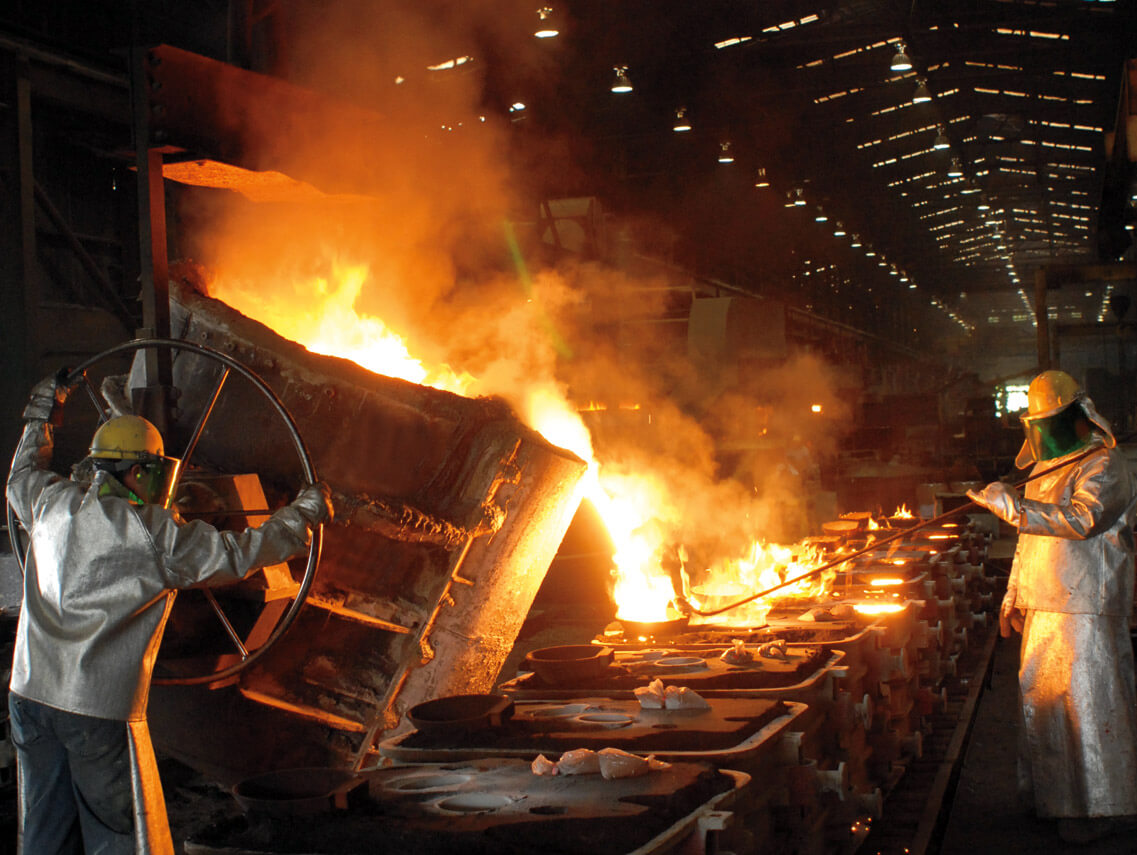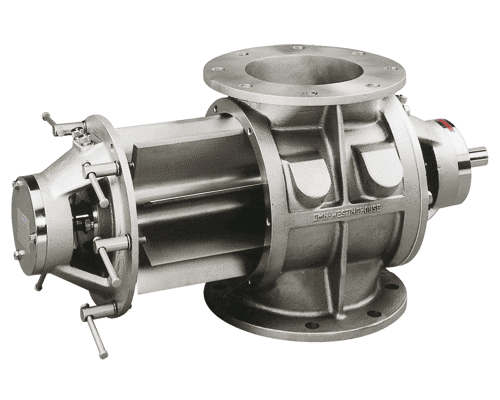 It is a well known fact that almost all the industries out there make use of Rotary Valves to their fullest capacity. In this web page, we will discuss the applications of the Rotary Valves in different industries around the world as well as the different types of Rotors used and the material they are composed of.
It is a well known fact that almost all the industries out there make use of Rotary Valves to their fullest capacity. In this web page, we will discuss the applications of the Rotary Valves in different industries around the world as well as the different types of Rotors used and the material they are composed of.
Before going into the details, let us enlist the few industries the Rotary Valves have made an impact in:
- Connector.Connector.

Aggregates
a material or structure formed from a mass of fragments or particles loosely compacted together.
- Connector.Connector.

Asphalt
a mixture of aggregates, binder and filler, used for constructing and maintaining all kind of roads and pavements.
- Connector.Connector.

Biomass
is biological material obtained from living or recently living plant matter that can be processed into electricity, fuel and heat.
- Connector.Connector.

Coal
is a combustible black or brownish-black sedimentary rock usually occurring in rock strata in layers or veins called coal beds or coal seams.
- Connector.Connector.

Dairy
harvesting or processing (or both) of animal milk – mostly from cows or goats, but also from buffaloes, sheep, horses, or camels.
- Connector.Connector.

Food
complex, global collective of diverse businesses that supply most of the food consumed by the world population.
- Connector.Connector.

Grain
small, hard, dry seeds, with or without attached hulls or fruit layers, harvested for human or animal consumption.
- Connector.Connector.

Mining
these are oil and gas extraction, coal mining, metal ore mining, nonmetallic mineral mining and quarrying
- Connector.Connector.

Paper
material produced by pressing together moist fibres of cellulose pulp derived from wood, rags or grasses, and drying them into flexible sheets.
- Connector.Connector.

Pharma
Pharmaceuticals develops, produces, and markets drugs or pharmaceuticals for use as medications. The process of drug manufacturing can be broken down into a series of unit operations, such as milling, granulation, coating, tablet pressing.
- Connector.Connector.

Powder Coating
type of coating that is applied as a free-flowing, dry powder. It does not require a solvent to keep the binder and filler parts in a liquid suspension form.
- Connector.Connector.

Steel Mills
industrial plant for the manufacture of an alloy of iron and other elements, primarily carbon, widely used in construction and other applications because of its high tensile strength.
- Connector.Connector.

Tobacco
companies involved in the manufacture of cigarettes, cigars, snuff, chewing tobacco and pipe tobacco.
- Connector.Connector.

Wood
is a porous and fibrous structural tissue found in the stems and roots of trees, and other woody plants. Used for construction, furniture and wood pulp for paper industry.
- Connector.Connector.

Agriculture
the science or practice of farming, including cultivation of the soil for the growing of crops and the rearing of animals to provide food, wool, and other products.
- Connector.Connector.

Baking & Milling
a method of cooking food that uses prolonged dry heat, normally in an oven. Milling breaks solid materials into smaller pieces by grinding, crushing, or cutting.
- Connector.Connector.

Cement
is a binder, a substance used in construction that sets and hardens and can bind other materials together.
- Connector.Connector.

Chemical
to convert raw materials (oil, natural gas, air, water, metals, and minerals) into more than 70,000 different products.
- Connector.Connector.

Energy / Power
production and sale of energy, including fuel extraction, manufacturing, refining and distribution.
- Connector.Connector.

Foundries
factory that produces metal castings. Metals are cast into shapes by melting them into a liquid, pouring the metal in a mold, and removing the mold material or casting after the metal has solidified as it cools.
- Connector.Connector.

Minerals
naturally occurring substance, representable by a chemical formula, that is usually solid and inorganic, and has a crystal structure.
- Connector.Connector.

Paint
liquid, liquefiable, or mastic composition that, after application to a substrate in a thin layer, converts to a solid film.
- Connector.Connector.

Pet Food
plant or animal material intended for consumption by pets, typically sold in pet stores and supermarkets.
- Connector.Connector.

Plastic
material consisting of any of a wide range of synthetic or semi-synthetic organics that are malleable and can be molded into solid objects of diverse shapes.
- Connector.Connector.

Rubber
lso called India rubber or caoutchouc, as initially produced, consists of polymers of the organic compound isoprene, with minor impurities of other organic compounds plus water.
- Connector.Connector.

Textile
or apparel industry is primarily concerned with the design and production of yarn, cloth, clothing, and their distribution. The raw material may be natural, or synthetic using products of the chemical industry.
- Connector.Connector.

Waste to Energy
(Wte) or energy-from-waste (EfW) is the process of generating energy in the form of electricity and/or heat from the primary treatment of waste.
Now that we know some of the industries they are used in. Let us take a closer look on the properties of the valves used and their functions. One fact that we must keep in mind is that industries rarely make use of open end rotary valves and you will mostly find closed end valves everywhere.
Aggregate Industry
 The Aggregate industry involves working with different minerals mined from the Earth’s core. The valves used in this industry need to be tough and should be able to take some abuse as they deal with Asphalt, cement and other abrasive materials. The function of the valves is used to convey product from a single inlet to the place of their usage.
The Aggregate industry involves working with different minerals mined from the Earth’s core. The valves used in this industry need to be tough and should be able to take some abuse as they deal with Asphalt, cement and other abrasive materials. The function of the valves is used to convey product from a single inlet to the place of their usage.
 For example the CI series of Rotary valves from ACS Valves shown on the right are normally used in the aggregate industry and are made up of either cast iron or stainless steel. It is a closed end rotary valve and can be seen in the figure below.
For example the CI series of Rotary valves from ACS Valves shown on the right are normally used in the aggregate industry and are made up of either cast iron or stainless steel. It is a closed end rotary valve and can be seen in the figure below.
This Rotary Valve is not just limited to the aggregates industry, but the same valve can be used in the Asphalt Industry.
Cement, Minerals & Coal

 The function of the Rotary Valve in the Cement industry is somewhat similar to the one explained above. The only difference is that these valves have a different composition to reliably convey all powder bulk materials in a cement plant, including raw meal, by-pass dust, clinker, cement, fly ash, pet coke, lignite and plastic fluff. The Rotary Valve is made up of mild steel but chrome layers are applied in different thicknesses on the housing bore, end plates and the rotor tips for lower conveying pressures and product hardness and Tungsten Carbide is used for the tips of the rotor. Ceramic is also used inside of the housing bore and on end plates for wear protection at high conveying pressures and hard materials like cement or alumina.
The function of the Rotary Valve in the Cement industry is somewhat similar to the one explained above. The only difference is that these valves have a different composition to reliably convey all powder bulk materials in a cement plant, including raw meal, by-pass dust, clinker, cement, fly ash, pet coke, lignite and plastic fluff. The Rotary Valve is made up of mild steel but chrome layers are applied in different thicknesses on the housing bore, end plates and the rotor tips for lower conveying pressures and product hardness and Tungsten Carbide is used for the tips of the rotor. Ceramic is also used inside of the housing bore and on end plates for wear protection at high conveying pressures and hard materials like cement or alumina.
 In the Minerals Industry, companies typically use rotary valves to meter materials from the outlets of silos, hoppers, cyclones, mixers, weighers and dust collectors. Two models of these valves are generally used, the drop through model and the blow through model. These rotary valves generally consist of a cast iron body, adjustable stainless steel tips and outrigger bearings. They are generally supplied with a geared motor, but are also available as a bare shaft. When used with particularly abrasive materials, all contact surfaces on the rotary valves are treated with a tungsten-carbide hardening process. The Mining Industry also involves the transport of minerals, but in the form of slurry liquid and thus a combination of these rotary valves is used together with diaphragm valves for the complete extraction.
In the Minerals Industry, companies typically use rotary valves to meter materials from the outlets of silos, hoppers, cyclones, mixers, weighers and dust collectors. Two models of these valves are generally used, the drop through model and the blow through model. These rotary valves generally consist of a cast iron body, adjustable stainless steel tips and outrigger bearings. They are generally supplied with a geared motor, but are also available as a bare shaft. When used with particularly abrasive materials, all contact surfaces on the rotary valves are treated with a tungsten-carbide hardening process. The Mining Industry also involves the transport of minerals, but in the form of slurry liquid and thus a combination of these rotary valves is used together with diaphragm valves for the complete extraction.

The Coal Industry requires a few special features otherwise it uses the same rotary valve made up of mild steel as used in minerals industries. The valves used have a generally high filling ratio due to a specially designed inlet and have minimum clearance as to minimize the loss of air. The use of external ball bearing makes the construction of the valve much sturdier and the rotor blades can be exchanged as well as adjusted according to requirements and the deposition of carbon soot.
Food and Pharmaceutical


Nearly all Food and Pharmaceutical product characteristics are easily managed, and the basic design of the valve in this regard can remain relatively simple without compromising hygiene and ease of use. Common product characteristics include being sticky, cohesive, and corrosive. There is a slight tendency to build-up on the swept surfaces etc. These valves are usually made of stainless steel with polished or non-stick coated surfaces. As abrasion is not normally an issue, relieved rotor vane tips are normally incorporated as standard; this minimizes the drive torque requirements should the product tend to build up on the internal rotor surfaces. One additional feature in these valves is that they are easy to clean as apparent from their figures.


Steel Mills & Foundries
 In Steel Mills the most important and fundamental part is the melt shop. Rotary discharge valves are in widespread use in melt shop baghouses. It is very important for the melt shops to function without interruptions. For that purpose, the rotary valves need to be designed as to ensure smooth continuous flow. The source material used is scrap steel and it is impossible to eliminate the presence of foreign objects so we need a rotary valve that ensures that these foreign objects do not get stuck between the rotor blades or the housing. The typical valves used in the steel industry are made of cast iron that have been treated to raise their working temperature but problems still do occur and cannot be fully eliminated. Due to this reason, the rotary valves are now slowly being replaced by double flap valves to prevent this problem from occurring.
In Steel Mills the most important and fundamental part is the melt shop. Rotary discharge valves are in widespread use in melt shop baghouses. It is very important for the melt shops to function without interruptions. For that purpose, the rotary valves need to be designed as to ensure smooth continuous flow. The source material used is scrap steel and it is impossible to eliminate the presence of foreign objects so we need a rotary valve that ensures that these foreign objects do not get stuck between the rotor blades or the housing. The typical valves used in the steel industry are made of cast iron that have been treated to raise their working temperature but problems still do occur and cannot be fully eliminated. Due to this reason, the rotary valves are now slowly being replaced by double flap valves to prevent this problem from occurring.
Foundries are very dusty places. Whether the dust is produced in mold making, metal melting, metal pouring, or finishing and treatment (heat treating, grinding, machining and finishing), the dust should be collected with a dust collector to provide a safe environment for your workers. The most common airlock used in foundries for dust collectors are rotary valves. The commonly used valves are made of cast iron with a slight modification. They come with an attached duckbill sleeve which can easily be replaced if it wears out from continuous usage. The same rotary valve can be used in the Wood industry to collect dust. In the Textile Industry, rotary feeders are also ideal for pollution control applications. 
A picture of such a valve is shown on the left and you can watch an animation of how the valve works click here.
Agricultural, Dairy, Tobacco and Grain
 The Agricultural Industry makes vast use of the rotary valves in many of its fields but they are most commonly used in the Dairy and Grain Industries.
The Agricultural Industry makes vast use of the rotary valves in many of its fields but they are most commonly used in the Dairy and Grain Industries.
Coming to the Dairy industry first, the function of the rotary valve is to move the product while providing a strictly hygienic environment. We need to prevent bacteriological risks and rule out contamination. AL/BL type rotary valve is used for the dairy industry. Some of the special features of this design are that there are no dead corners (no angle smaller than 135°). The rotor pockets are rounded with the rotor blades beveled on three sides. All the points that come into contact with the product are polished. There are special seals that keep the flow even and can easily be inspected. This model can also easily be demounted without the help of tools. The rotary valve can be seen in the figure.

The Tobacco industry also falls under the category of agriculture. The rotary valves are basically used to divide the tobacco into finer particles by passing it through the blades of the rotor.  A simple cast iron rotor is sufficient to fulfill this purpose and does not require any additional add-ons.
A simple cast iron rotor is sufficient to fulfill this purpose and does not require any additional add-ons.
In the Grain Industry, a rotary valve or an injector delivers the grain into the pipeline in pressure conveying systems. A rotary intake unit is used for larger capacities. This is driven by a small motor that increases the capacity significantly in comparison with an injector. Some of the significant features of the rotary valves that are used are that they use rubber slats which serve as an excellent seal against air loss. In addition to preventing the air from escaping, these rubber slats can also bend to eliminate clogging. The whole system is shown below.

Biomass and Waste to Energy
 Like the mineral industry, the Biomass Industry also requires a rotary valve that can take a beating and still continue to function smoothly. The biomass industry requires the rotary valve to feed biomass fuel into the power boiler while at the same time serve as a lock to prevent the back-flow of gases and flame.
Like the mineral industry, the Biomass Industry also requires a rotary valve that can take a beating and still continue to function smoothly. The biomass industry requires the rotary valve to feed biomass fuel into the power boiler while at the same time serve as a lock to prevent the back-flow of gases and flame.
It also serves as dosing valve at silo outlet to prevent the uncontrolled discharge of material out of the silo.  The same rotary valve becomes a mean for energy generation and serves in the Power industry in similar fashion by converting Waste to Energy.
The same rotary valve becomes a mean for energy generation and serves in the Power industry in similar fashion by converting Waste to Energy.
Standard Valves used can be made up of Cast Iron, SG Iron, Ni-hard or Carbon steel. To further enhance durability replaceable body liner can be hard chromed or ceramic coated. Rotor shaft sealing options include various types of gland packing, mechanical seals, air or grease purge.
Chemical Industry

 The Chemical industry involves the moving of pure and sensitive chemicals, whose purity cannot be compromised. These valves also require regular inspection and cleaning to ensure no mishaps occur.
The Chemical industry involves the moving of pure and sensitive chemicals, whose purity cannot be compromised. These valves also require regular inspection and cleaning to ensure no mishaps occur.
The valves used in this industry usually come with a rotor side-bearing mechanism, which makes it possible to open and close the side plate at a single touch, and attachment and detachment of the rotor can also be accomplished simply by removing the single center bolt. Such a rotary valve can be viewed on the right.
Baking and Milling Industry
 Baking and Milling Industries requires feeding powdery or granular materials into a conveying system. For this purpose Blow-Through rotary valves are used as these enhance rotor clean-outs and can be installed in tight quarters.
Baking and Milling Industries requires feeding powdery or granular materials into a conveying system. For this purpose Blow-Through rotary valves are used as these enhance rotor clean-outs and can be installed in tight quarters.
The housing and end plates of the rotors used are machined from castings and are made of wear iron or chrome-plated wear iron. Eight blades maintain a minimum two-blade labyrinth seal to minimize air leakage. The rotors are equipped with relieved tips for materials which form skins or thin sheets on end plates and housing, or non-relieved tips for cereal products. The two types are shown below.

Pet Food Industry
 The Pet Food industry’s regulations are demanding. Cross contamination is a real concern, so regular equipment cleaning is necessary. We need a rotary valve that is easy to disassemble, clean and reassemble. The Valves used can be made up of stainless steel, chrome-plated grey cast iron, nickel-plated grey cast iron or grey cast iron. The surfaces are smooth and polished and sometimes coated with Teflon. You can see the different valves below.
The Pet Food industry’s regulations are demanding. Cross contamination is a real concern, so regular equipment cleaning is necessary. We need a rotary valve that is easy to disassemble, clean and reassemble. The Valves used can be made up of stainless steel, chrome-plated grey cast iron, nickel-plated grey cast iron or grey cast iron. The surfaces are smooth and polished and sometimes coated with Teflon. You can see the different valves below.

Powder
 In typical Powder metering applications, the rotor speed is controlled to provide a controlled flow of product into a convey line, hopper or into a vacuum pick-up vessel prior to conveying. By controlling the flow of product, we can ensure that powders can be effectively conveyed from one source to a destination at a constant rate to match the application.
In typical Powder metering applications, the rotor speed is controlled to provide a controlled flow of product into a convey line, hopper or into a vacuum pick-up vessel prior to conveying. By controlling the flow of product, we can ensure that powders can be effectively conveyed from one source to a destination at a constant rate to match the application.
The model of the rotary valve uses an eccentric structure in which the intake port and discharge port are offset, thereby reducing the volume efficiency of powders in the rotor pocket. Furthermore, special edge machining for the rotor prevents powder bite between the rotor and casing. This can be seen in the following image.

Paper Making
 Paper Making is a very delicate process and even the slightest imbalance can greatly affect the quality of the paper being produced. The rotary valves come in during the drying process of the paper and are responsible for regulating the flow of the steam such that the paper dries at the desired ideal rate. This valve is almost always made of stainless steel and can be seen in below.
Paper Making is a very delicate process and even the slightest imbalance can greatly affect the quality of the paper being produced. The rotary valves come in during the drying process of the paper and are responsible for regulating the flow of the steam such that the paper dries at the desired ideal rate. This valve is almost always made of stainless steel and can be seen in below.

